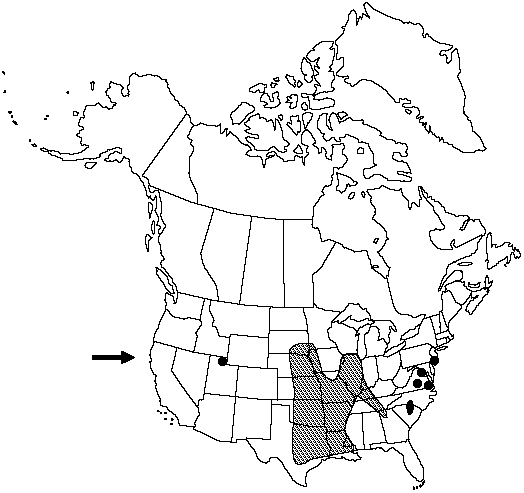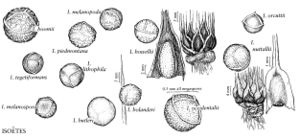Difference between revisions of "Isoëtes melanopoda"
Bull. Soc. Bot. France 11: 102. 1864.
FNA>Volume Importer |
imported>Volume Importer |
||
| (6 intermediate revisions by 2 users not shown) | |||
| Line 23: | Line 23: | ||
|habitat=Noncalcareous soil, meadows, fields, ditches, soil pockets on rock outcrops | |habitat=Noncalcareous soil, meadows, fields, ditches, soil pockets on rock outcrops | ||
|distribution=Ark.;Ga.;Ill.;Ind.;Iowa;Kans.;Ky.;La.;Minn.;Miss.;Mo.;Nebr.;N.J.;N.C.;Okla.;S.C.;S.Dak.;Tenn.;Tex.;Utah;Va. | |distribution=Ark.;Ga.;Ill.;Ind.;Iowa;Kans.;Ky.;La.;Minn.;Miss.;Mo.;Nebr.;N.J.;N.C.;Okla.;S.C.;S.Dak.;Tenn.;Tex.;Utah;Va. | ||
| − | |discussion=<p>Population of Isoëtes melanopoda in New Jersey, North Carolina, South Carolina, Utah, and Virginia are disjunct.</p><!-- | + | |discussion=<p>Population of <i>Isoëtes melanopoda</i> in New Jersey, North Carolina, South Carolina, Utah, and Virginia are disjunct.</p><!-- |
| − | --><p>Plants of Isoëtes melanopoda with black leaf bases are typical. Plants without black leaf bases have been called I. melanopoda f. pallida (Engelmann) Fernald. Variation also occurs in megaspore morphology. A collection from Dallas County, Texas, has lustrous black leaf bases and boldly rugulate spores with ridges that occasionally anastomose. In many respects, I. melanopoda is similar to I. howellii.</p> | + | --><p>Plants of <i>Isoëtes melanopoda</i> with black leaf bases are typical. Plants without black leaf bases have been called <i>I. melanopoda</i> f. pallida (Engelmann) Fernald. Variation also occurs in megaspore morphology. A collection from Dallas County, Texas, has lustrous black leaf bases and boldly rugulate spores with ridges that occasionally anastomose. In many respects, <i>I. melanopoda</i> is similar to <i>I. howellii</i>.</p> |
|tables= | |tables= | ||
|references= | |references= | ||
| Line 33: | Line 33: | ||
-->{{#Taxon: | -->{{#Taxon: | ||
name=Isoëtes melanopoda | name=Isoëtes melanopoda | ||
| − | |||
|authority=Gay & Durieu | |authority=Gay & Durieu | ||
|rank=species | |rank=species | ||
| Line 47: | Line 46: | ||
|publication year=1864 | |publication year=1864 | ||
|special status= | |special status= | ||
| − | |source xml=https:// | + | |source xml=https://bitbucket.org/aafc-mbb/fna-data-curation/src/2e0870ddd59836b60bcf96646a41e87ea5a5943a/coarse_grained_fna_xml/V2/V2_482.xml |
|genus=Isoëtes | |genus=Isoëtes | ||
|species=Isoëtes melanopoda | |species=Isoëtes melanopoda | ||
Latest revision as of 20:23, 5 November 2020
Plants terrestrial or becoming so. Rootstock nearly globose, 2-lobed. Leaves deciduous, bright green, pale to lustrous black toward base, spirally arranged, to 40 cm, pliant, tapering gradually to tip. Velum covering less than 3/4 sporangium. Sporangium wall brown-streaked. Megaspores white, 280–440 μm diam., obscurely rugulate with low ridges, rarely tuberculate or reticulate; girdle obscure. Microspores gray in mass, 20–30 μm, spinulose. 2n = 22.
Phenology: Spores mature in late spring.
Habitat: Noncalcareous soil, meadows, fields, ditches, soil pockets on rock outcrops
Distribution

Ark., Ga., Ill., Ind., Iowa, Kans., Ky., La., Minn., Miss., Mo., Nebr., N.J., N.C., Okla., S.C., S.Dak., Tenn., Tex., Utah, Va.
Discussion
Population of Isoëtes melanopoda in New Jersey, North Carolina, South Carolina, Utah, and Virginia are disjunct.
Plants of Isoëtes melanopoda with black leaf bases are typical. Plants without black leaf bases have been called I. melanopoda f. pallida (Engelmann) Fernald. Variation also occurs in megaspore morphology. A collection from Dallas County, Texas, has lustrous black leaf bases and boldly rugulate spores with ridges that occasionally anastomose. In many respects, I. melanopoda is similar to I. howellii.
Selected References
None.
